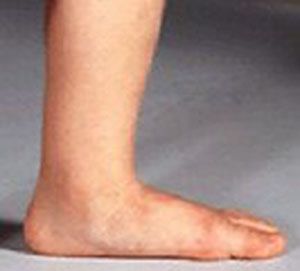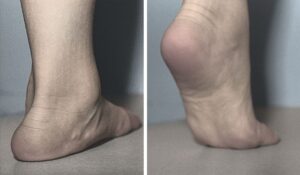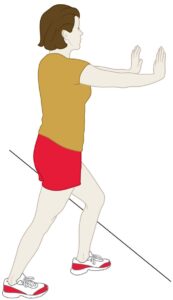Flexible flatfoot is a prevalent condition in children characterized by the temporary disappearance of the foot’s arch when standing. However, the arch typically reappears when the child sits or stands on tiptoes. This condition, known as “flexible flatfoot,” invariably affects both feet.
Parents often worry that low or absent arches in their child’s feet might lead to long-term deformities or mobility issues. However, in most cases, children naturally outgrow flexible flatfoot without any complications in adulthood. The condition is typically painless and does not hinder walking, running, or participation in sports. If your child’s flexible flatfoot is not causing pain or discomfort, treatment is generally unnecessary.
 Flexible flatfoot, showing the absence of an arch when standing. The arch reappears when the patient is sitting or on tiptoes.
Flexible flatfoot, showing the absence of an arch when standing. The arch reappears when the patient is sitting or on tiptoes.
Description
Flexible flatfoot is considered a normal variation of foot development. In this condition, the muscles and joints in the foot function properly despite the absence of a visible arch when standing.
Most children are born with minimal or no arch in their feet. As they grow and begin walking, the soft tissues in the soles of their feet naturally tighten, gradually forming the arches over time.
In many cases, children with flexible flatfoot do not show significant arch development until they reach the age of 5 or older. However, some children may never develop a visible arch.
If flexible flatfoot persists into adolescence, it can sometimes lead to aching or discomfort along the soles of the feet. In cases where a child experiences consistent or severe foot pain, it is important to consult a doctor for evaluation and appropriate care.
 The arch disappears when standing (left) and reappears when the child is on tiptoes (right).
The arch disappears when standing (left) and reappears when the child is on tiptoes (right).
Treatment
Nonsurgical Treatment
Treatment for flexible flatfoot is typically only necessary if the condition causes discomfort or pain for your child.
Stretching Exercises
For children experiencing activity-related pain or fatigue in the feet, ankles, or legs, stretching exercises may be recommended by a doctor. One effective stretch for this condition is the heel cord stretch:
- Stand facing a wall with one foot forward and the other extended back.
- Keep your back leg straight, pressing the heel firmly into the ground, while bending the front knee.
- Ensure both heels remain flat on the floor, and the toes of your back foot point toward the heel of your front foot.
- Hold the stretch for 15 to 30 seconds, then repeat three times on each leg.
This exercise helps loosen tight heel cords and can alleviate associated pain.
Shoe Inserts (Orthotics)
If discomfort persists, the doctor may recommend shoe inserts. Arch supports—available in soft, firm, or hard-molded designs—can reduce foot pain and fatigue while promoting even wear in your child’s shoes.
In most cases, over-the-counter arch supports are sufficient and much more cost-effective than custom-molded options, especially as your child’s feet grow. These inserts are widely available in sporting goods stores, running shoe retailers, and online, including sizes that can be hard to find elsewhere.
Additional Treatment Options
For children with flexible flatfoot accompanied by tight heel cords, a doctor may also suggest physical therapy or casting to provide additional relief and improve flexibility.
 A child at 3 years of age (left) with flexible flatfoot. The same child at 15 years of age (right) has a normal arch despite having received no treatment.
A child at 3 years of age (left) with flexible flatfoot. The same child at 15 years of age (right) has a normal arch despite having received no treatment.
Surgical Treatment
Surgery is rarely required to address flexible flatfoot in children. However, in some cases, it may be recommended for adolescents who experience persistent pain or if the condition progresses to a rigid flatfoot over time.
The primary goal of surgery is to create arches in the feet by reshaping the bones and lengthening tight tendons that may be contributing to discomfort. This procedure is typically performed in stages: one foot is corrected first, followed by a recovery period of several months before addressing the other foot.
Surgical options involving the placement of artificial implants, such as metal or silicone devices, into the joint between the foot and ankle to create an arch are not well-researched in children and adolescents. As a result, this approach should be considered cautiously and only after thorough evaluation by a specialist.





